The human bicep has both an inner and an outer head, meaning that you need to train it from different angles and with a variety of bicep exercises to get the best results. This also applies to the pectorals, which, like the biceps, are split into two main heads—a clavicular head and a sternal head.
Since chest and biceps movements don’t interfere with each other, the pecs and biceps are great muscles to train together on the same day. So, in addition to a list of the most effective exercises for the pecs and bis, we created some chest and bicep workout routines that you can follow to build muscle.
Related Post: Back and biceps workout
12 best chest and bicep exercises
If you want to create your own custom bicep and chest workout, then you can select from these highly effective exercises in order to craft your own program.
1. Incline alternating dumbbell curls
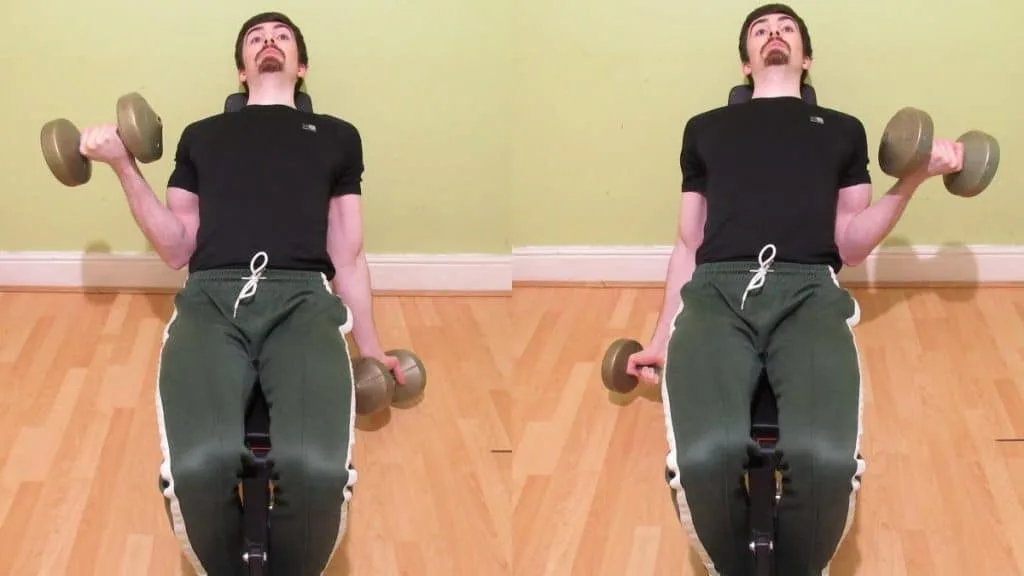
Performing alternate incline dumbbell curls in your chest and bis workout is a brilliant idea because incline curls place the biceps under a tremendous stretch. This deep stretch helps to break down large amounts of muscle fibers so that your biceps grow back bigger and stronger.
Alternating incline curls also enable you to perform more reps than the non-alternate version because your biceps get a short break after each rep. This means that your biceps are less fatigued by the time their next rep rolls around.
If you don’t have access to an incline bench, then you can simply do alternate dumbbell curls in a standing position instead. While you won’t get the same kind of muscle stretch, you’ll actually be able to lift slightly more weight by ditching the incline bench. So, in the end, you’ll probably get similar results from both exercises.
- Position the back pad of an adjustable bench to between 45-60 degrees.
- Grab two dumbbells with an underhand grip and then sit on the bench.
- Let your arms hang over either side of the bench so that the weights are slightly behind your hips.
- Curl the weights toward your shoulders while keeping your elbows as still as possible.
- Keep lifting the weights until the undersides of your forearms press right up against your biceps.
- Hold the peak contraction for a moment, and then lower the dumbbells under control until your elbows reach full extension.
- Repeat for 3-5 sets of 8-12 reps.
2. Rope hammer curls
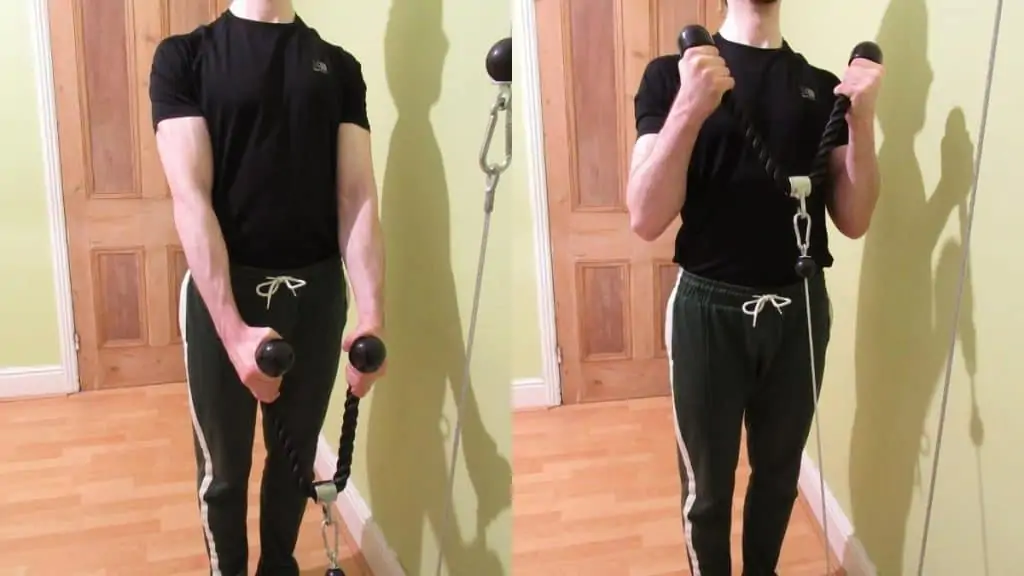
The rope cable hammer curl is an excellent addition to any biceps and chest workout because it trains the brachialis and brachioradialis muscles as well as the biceps. Therefore, it’s an ideal movement for gaining overall arm size and one which enables you to lift heavier weights than on regular cable arm curls.
Cable hammer curls also provide constant tension. This means that your arms have to work harder because they can’t really rest effectively at any point during the set. With free-weight curls, on the other hand, you can easily relax at the bottom of every rep when your elbows are locked out. So in this regard, cable movements are a great exercise for chest and biceps development.
You can also do sitting dumbbell hammer curls (on your sofa or on a chair) instead if you train at home and only have access to free weights.
- Connect a rope attachment to a low pulley.
- Grab the rope with a neutral grip and hold it in front of your thighs.
- Lift the rope toward your chest while keeping your elbows and shoulders still.
- Squeeze your biceps and forearms as they make firm contact with each other.
- Hold the contraction for a moment.
- Lower the rope under control until your arms are locked out.
- Perform 3-5 sets of 10-15 reps.
3. Incline dumbbell bench press
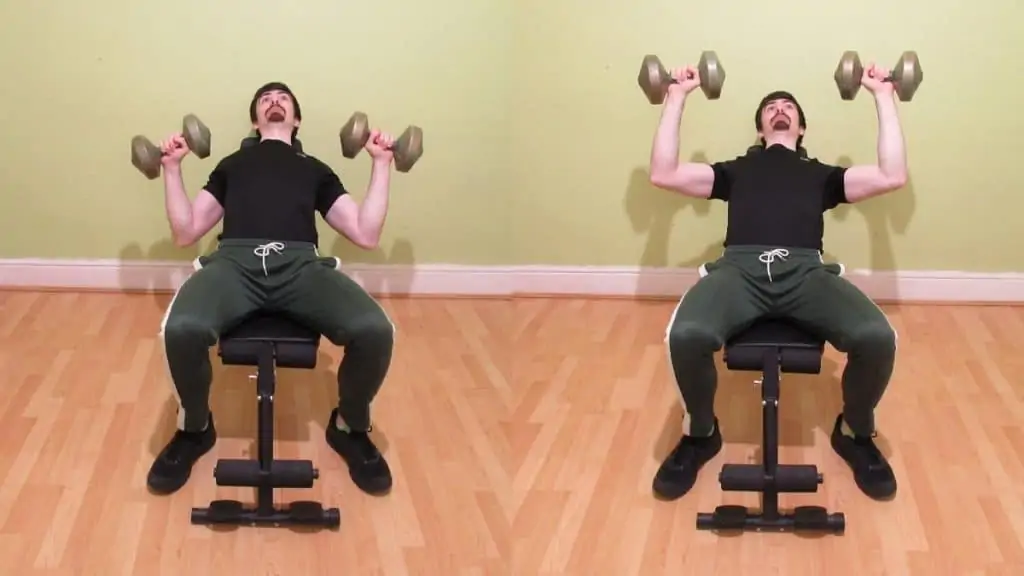
Including the incline dumbbell press in your chest and bicep workouts is a brilliant idea if you have an underdeveloped upper chest. The trick is to use a moderate incline (30 degrees) so that you don’t turn the movement into a front delt exercise. You’ll also be able to lift heavier weights and thus stimulate greater chest hypertrophy when the incline isn’t overly steep.
Additionally, doing your incline presses with dumbbells rather than with a barbell permits a bigger range of motion. This enables you to achieve a deeper stretch in your pecs as well as a stronger contraction at the top of the rep.
- Set the backrest of an adjustable bench to between 30-45 degrees.
- Grab a pair of dumbbells, and then sit on the bench with the weights resting on your knees.
- Kick the dumbbells back by moving your knees up and then lie back on the bench with your scapula retracted.
- Tuck your elbows in at a 45-degree angle.
- Press the weights up and in until your elbows reach full extension.
- Lower the dumbbells down to your chest until you feel a deep yet comfortable pectoral stretch.
- Repeat for 3-5 sets of 8-12 reps.
4. Cable chest fly

If you want to get a massive chest pump and spare your shoulders, then make sure to do cable flys rather than dumbbell flys during your chest and biceps workout routine. Unlike free-weight flys, cable flys provide constant tension and a far stronger peak contraction, meaning that your chest muscles have to work much harder to resist the weight.
While you can do this exercise standing, your best bet is to perform it with your back against a bench so that your core strength isn’t the limiting factor. Better yet, you can use a dedicated cable fly station if your gym has one.
- Position a weight bench in the middle of a cable crossover and set the backrest to a 90-degree angle (or somewhere close to it). Alternatively, use a dedicated cable fly station.
- Position the pulleys in the middle of the cable columns and attach a single handle to each side.
- Grab the handles and then sit on the bench.
- Perform a fly motion by moving your hands toward each other (as if you’re hugging a tree).
- Squeeze your pecs forcefully as the handles come into contact.
- Reverse the motion by arcing the handles out and backward while keeping a slight bend in your elbows.
- Maintain this fly motion until you feel a deep yet comfortable stretch in your chest.
- Repeat for 3-5 sets of 12-20 reps.
5. Reverse drag curl
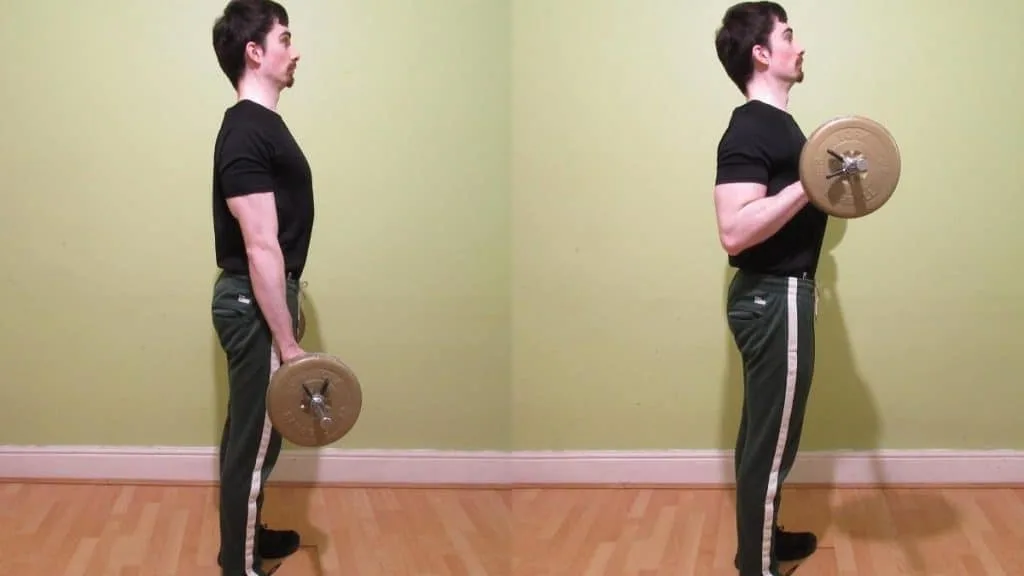
Reverse grip drag curls are an excellent way to add variety to your chest and bi workout because they actually focus on the brachialis and brachioradialis rather than the biceps.
This is because using an overhand grip puts the biceps in a weak position in which they can’t produce much force. As a result, the brachialis and brachioradialis have to do most of the lifting, which means that they also get to enjoy most of the muscle-building tension.
Developing the brachialis will actually push your biceps out and make them look more peak. Similarly, building the brachioradialis will thicken the tops of your forearms and give you more overall arm size. So this definitely isn’t an exercise that you want to skip, even though it’s not technically a bicep-dominant movement.
You can also do the standing reverse cable curl if you want to challenge your muscles with constant tension and add variety to your chest and biceps exercises.
- Load some weight onto a bar and grab it with a thumbless overhand grip.
- Drag the bar up your body by moving your hands toward your shoulders while simultaneously dragging your elbows behind your torso.
- Keep dragging the bar upward until the tops of your forearms make forceful contact with your biceps. Avoid shrugging the weight up.
- Hold the peak contraction for a moment.
- Lower the bar back down—keep it in contact with your body—until your elbows reach full extension.
- Perform 3-5 sets of 12-20 reps.
6. Barbell preacher curl

The preacher bench barbell curl should be a staple in any good chest and bicep workout, especially one that’s aimed at beginners. This is because by bracing your arms against the preacher pad and planting your lower body on the seat, it’s virtually impossible to swing the weight up with your shoulders, hips, or back.
As a result, the Scott curl exercise is ideal for beginners because it enables them to easily lift with the proper form. This means that they’re less likely to get injured or overtrain by lifting excessively heavy weights.
Of course, if you’ve been in the gym for a while, then you can still benefit from doing barbell preacher curls. After all, many advanced lifters still use sloppy form and could really use the helping hand that the preacher pad provides.
- Load some weight onto a bar and then place it in the preacher curl rack.
- Sit on the bench and brace your arms against the pad.
- Grab the bar with an underhand grip and curl it toward your shoulders.
- Keep curling the bar until your forearms press right up against your biceps.
- Hold the contraction for a second, and then lower the bar back down until your elbows reach full extension.
- Repeat for 3-5 sets of 8-12 rep.
7. Decline bench press
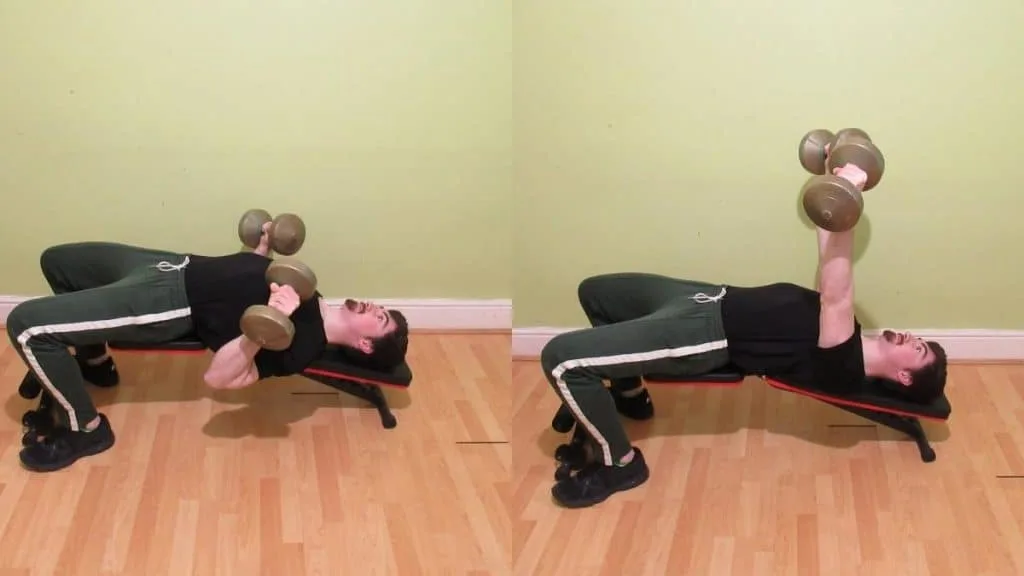
A good chest and biceps workout plan usually includes some kind of barbell bench press so that you can overload your pecs with the heaviest possible resistance levels. However, by performing the decline press rather than the flat press, you can lift even heavier weights and put yet more tension through your pecs to build that all-important chest mass.
The decline press works with both dumbbells and barbells. However, unless you have someone to help you get the dumbbells into position, then you’ll probably want to stick to the barbell version for the time being.
- Place a bar in the decline bench rack and add some weights to either side.
- Lie back on the bench with your scapula retracted.
- Grab the bar firmly just outside shoulder width. Do not use a thumbless grip.
- Tuck your elbows in at a 45-degree angle, and then lift the barbell out of the bar holder.
- Lower the barbell down until it touches your chest.
- Immediately press the weight back up—keeping going until your elbows reach lockout.
- Repeat for 3-5 sets of 8-12 reps.
8. Machine chest press
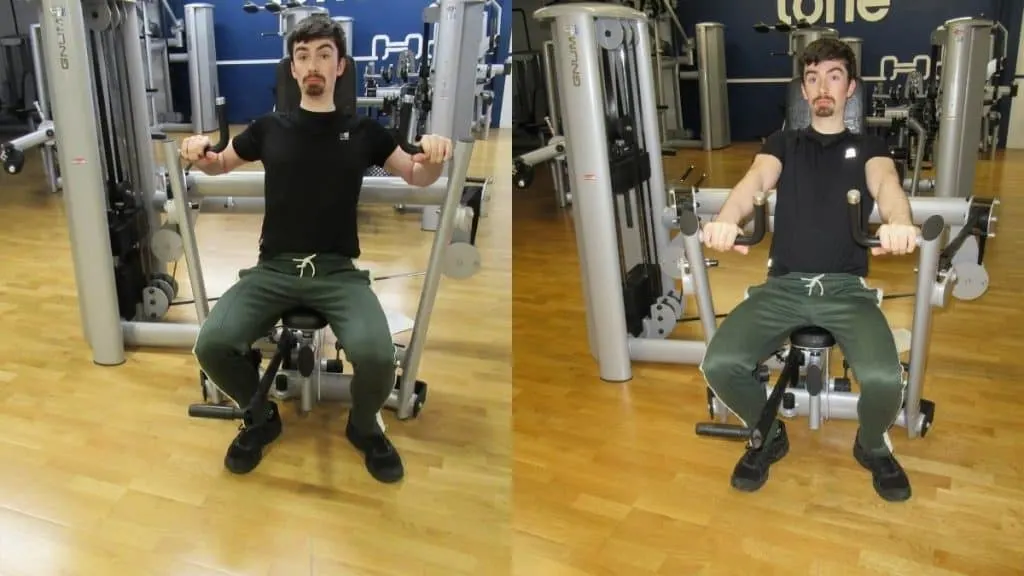
Machine exercises are the optimal way to finish your chest bicep workout routine because they enable you to focus purely on the working muscles and thus ensure that your pecs and bis are thoroughly fatigued.
Movements like the chest press are also ideal for beginners because they require less stabilization than their free weight equivalents. This enables you to focus on gaining strength (and thereby muscle) rather than on learning the technique for weeks on end.
- Sit on a chest press station and grab the handles with an overhand grip.
- Pin your shoulders blades back and stick your chest out.
- Tuck your elbows in slightly, and then press the handles forward until your arms are locked out.
- Reverse the motion by moving the handles back toward your chest.
- Keep going until you feel a deep but comfortable stretch in your pecs.
- Repeat for 3-5 sets of 10-15 reps.
9. Zottman curls
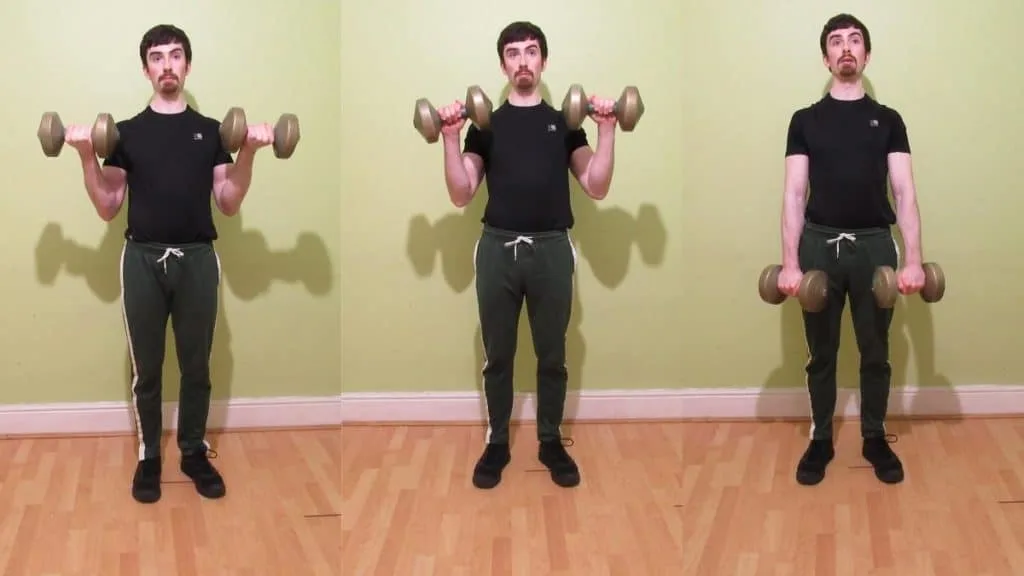
Including Zottman bicep curls in your chest and biceps routine is a time-efficient way to build muscle. This is because, unlike regular curls, Zottman curls also train the brachialis and brachioradialis muscles to a considerable extent since you’re using your biceps during the concentric to overload your brachialis and brachioradialis during the eccentric.
So if you want muscular arms in general (and not just overly-dominant biceps), then exercises such as the sitting Zottman curl should be a staple in your routine.
- Hold a pair of weights by your sides with an underhand grip.
- Curl the dumbbells toward your shoulders while keeping your elbows stationary.
- Turn your hands into a pronated (palms-down) position as your biceps and forearms make firm contact at the top of the rep.
- Lower the weights down with this new pronated grip until the dumbbells are back by your sides.
- Switch back to the original supinated grip and repeat for 3-5 sets of 8-15 reps.
10. Strict curl
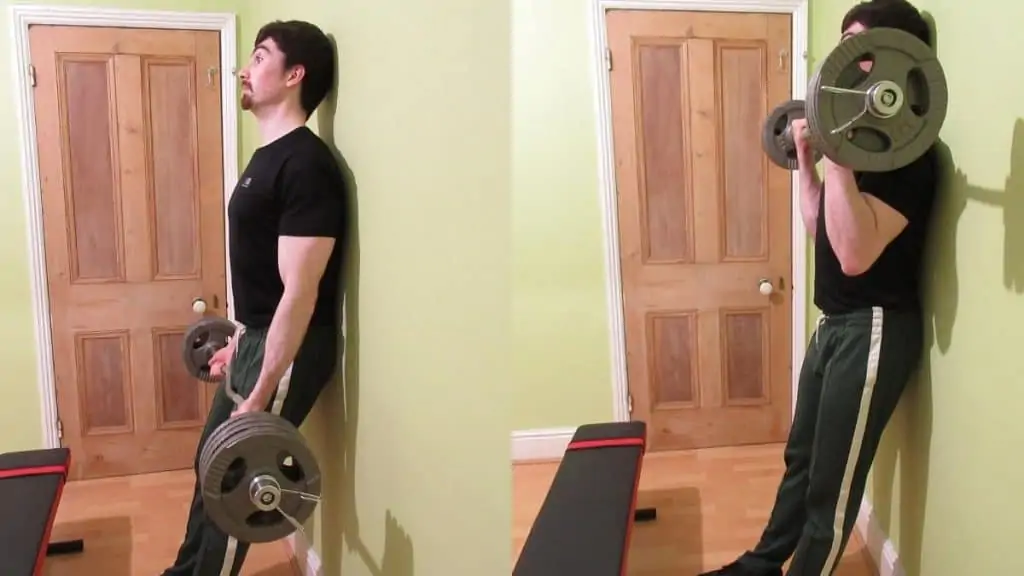
If you’re creating your own workouts for the biceps and chest and want to stimulate maximum muscle hypertrophy, then the strict bicep curl is one of the best exercises that you can do. After all, no other movement isolates the biceps quite like a momentum-free strict curl.
The only slight downside is that, while the exercise is undeniably tough on the biceps, it can be even harder on the ego. That’s right; you’re probably going to have to lighten the weight for this one. But if it gets your biceps growing, then who cares if you feel temporarily weaker?
- Load some weight onto a bar and then grab it with a shoulder-width underhand grip.
- Stand with your back and glutes pressed against the wall.
- Curl the bar toward your chest while keeping your elbows and shoulders relatively still.
- Squeeze your biceps at the top of the rep as they press up against your forearms.
- Hold the contraction for a second and then lower the weight back down until your elbows reach full extension.
- Perform 3-5 sets of 8-12 reps.
11. Push-ups

If you’re doing a chest and bicep workout at home or just want to build mass by focusing on the proven basics, then push-ups are one of the best exercises that you can do.
Not only are they much safer than the bench press (especially if you don’t have a spotter), but they can build just as much muscle. If you can already do 20 push-ups, then you can easily wear a weighted vest to increase the resistance and keep the gains coming in. After all, it’s not like your chest muscles can figure out whether you’re pushing a barbell or pushing against the floor!
- Place your hands shoulder-width apart on the floor and flare them out slightly.
- Extend your legs back and put your feet together.
- Tuck your elbows in at a 45-degree angle.
- Lower your chest down to the ground by bending your elbows.
- Push yourself back up once your chest touches the floor.
- Repeat for 3-5 sets of 12-20 reps.
12. Chest fly machine
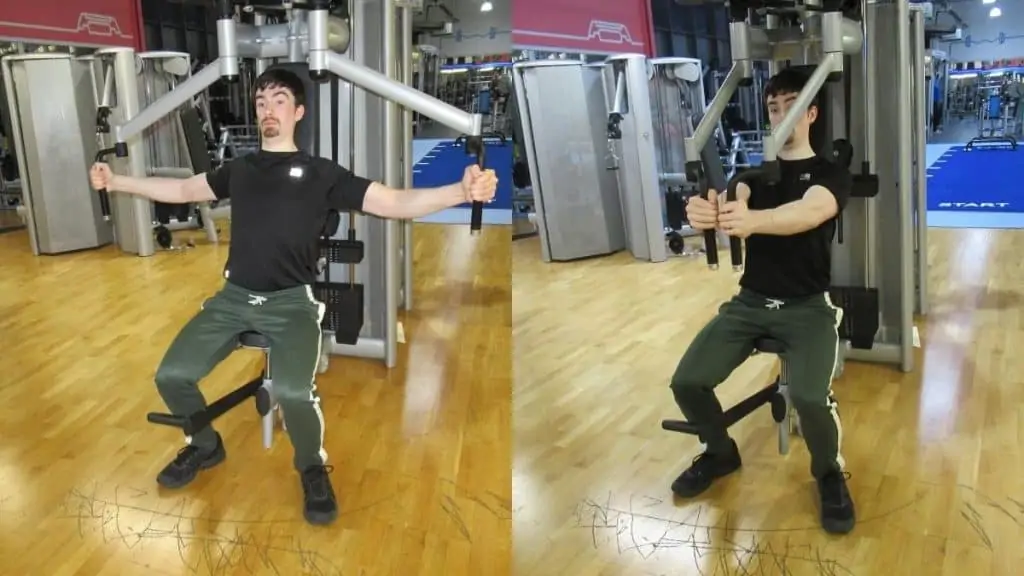
Using the pec fly machine is a great way to end your chest biceps routine because it’ll pump up your pecs while also ensuring that the remaining muscle fibers get enough stimulation to grow back thicker.
- Sit on the chest fly station’s seat.
- Adjust the handles on the fly machine so that they’re in line with the sides of your shoulders.
- Grab the handles and move them toward each other like you’re giving someone a hug.
- Squeeze your pecs forcefully as the handles touch.
- Reverse the movement by arcing the handles back in a reverse fly motion.
- Keep going until you feel a good (but not excessive) stretch in your chest.
- Repeat for 3-5 sets of 12-20 reps.
Best chest and bicep workout routines
Now that you’ve seen the most effective exercises for the two muscle groups, it’s time to actually work out your chest and biceps together in a fully-fledged routine.
All of these bicep and chest workouts will build a significant amount of muscle if you perform them consistently (1-2 times per week). Similarly, each has a different theme. For example, there’s a time-saving chest and biceps superset workout as well as a routine that you can do at home. So no matter what your ability level is or your training goals are, you’ll find a great chest and bis workout plan within these four routines.
Chest and bicep workout for beginners
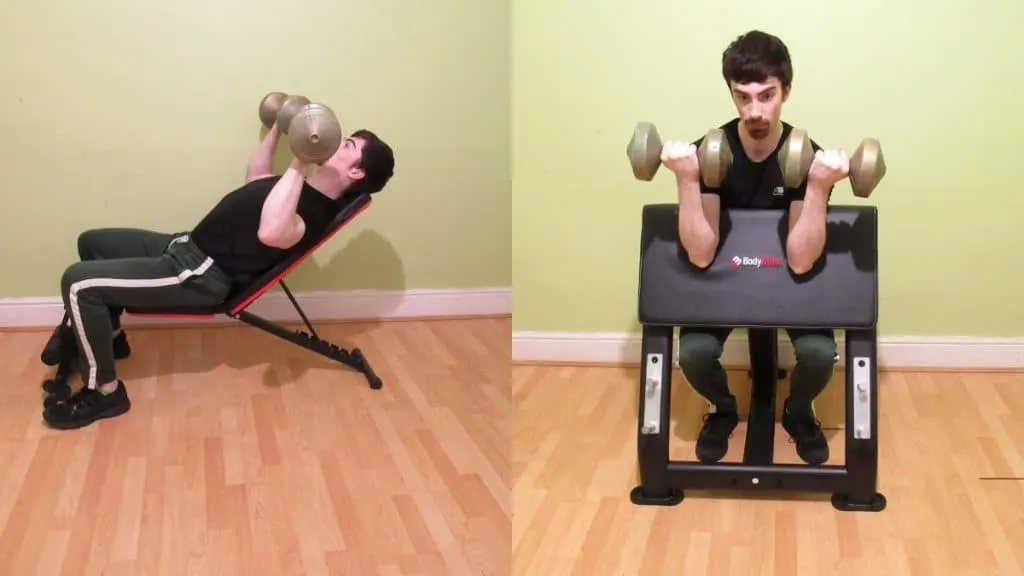
1: Flat bench press — 3-5 sets of 6-8 reps
2: Preacher curl — 3-5 sets of 8-10 reps
3: Incline dumbbell press — 3-5 sets of 8-12 reps
4: Cable hammer curl — 3-5 sets of 12-15 reps
This is the best chest and bicep workout routine to do if you’re a beginner because it provides enough training volume to build muscle, but not so much that you risk overtraining or getting injured (unless, of course, you use improper form).
The workout begins with the flat bench press to build overall mass, which you can perform with either dumbbells (my choice because dumbbells provide a deeper stretch) or a barbell.
Preacher curls promote strict form and thus optimal bicep development because you can’t cheat the weight up when your arms are braced against the pad. Of course, if you’re short on equipment or if you’re training at home, then you can also do regular curls instead.
The incline press is the second pec exercise in this chest and biceps workout for beginners and one which will really build the upper pectorals as well as the front delts.
Finally, the routine ends with cable hammer curls to finish off the biceps as well as the brachialis and brachioradialis.
Aim to rest 2-4 minutes between sets. While it’s true that shorter rest periods will lead to a better pump, it’s more important to lift heavy as a beginner than it is to train for the pump and burn.
Chest and bicep superset workout

1A: Flat dumbbell press — 3-5 sets of 8-10 reps
1B: Dumbbell curls — 3-5 sets of 8-10 reps
2A: Incline dumbbell press — 3-5 sets of 10-12 reps
2B: Incline dumbbell curl — 3-5 sets of 10-12 reps
3A: Cable fly — 3-5 sets of 15-20 reps
3B: Reverse cable curl — 3-5 sets of 15-20 reps
This superset chest and biceps workout routine will pump up your pecs and blast your bis in a fraction of the time that it takes to perform a regular session.
We paired exercises together that use similar equipment so that you don’t have to waste time and energy by walking halfway across the free weight area to change exercises (and risk your bench being taken!)
Perform the exercises back-to-back or take a 30-60 second break between movements if you need to catch your breath.
After you’ve done one superset, rest for a full minute so that you can still lift a decent amount of weight on your next sets.
Of course, this chest and bicep superset workout is very intense. So if you’re a beginner, then make sure to build a foundation of mass before attempting a routine that’s as challenging as this one.
Chest and biceps workout at home

1: Push-ups — 3-5 sets of 10-30 reps
2: Dumbbell curls — 3-5 sets of 8-15 reps
3: Dumbbell press — 3-5 sets of 10-15 reps
4: Strict curl — 3-5 sets of 10-15 reps
This home chest and biceps workout assumes that you have access to dumbbells and a weight bench.
Yet, if you have weights but no bench, then you can simply do extra push-ups or substitute the bench press for the floor press instead.
Again, you want to rest 2-4 minutes between each set so that you can still perform your subsequent sets with a decent amount of resistance.
If you just want to work your biceps on their own, then you can see our home bicep workout guide for more routines.
Chest and bicep workout for mass
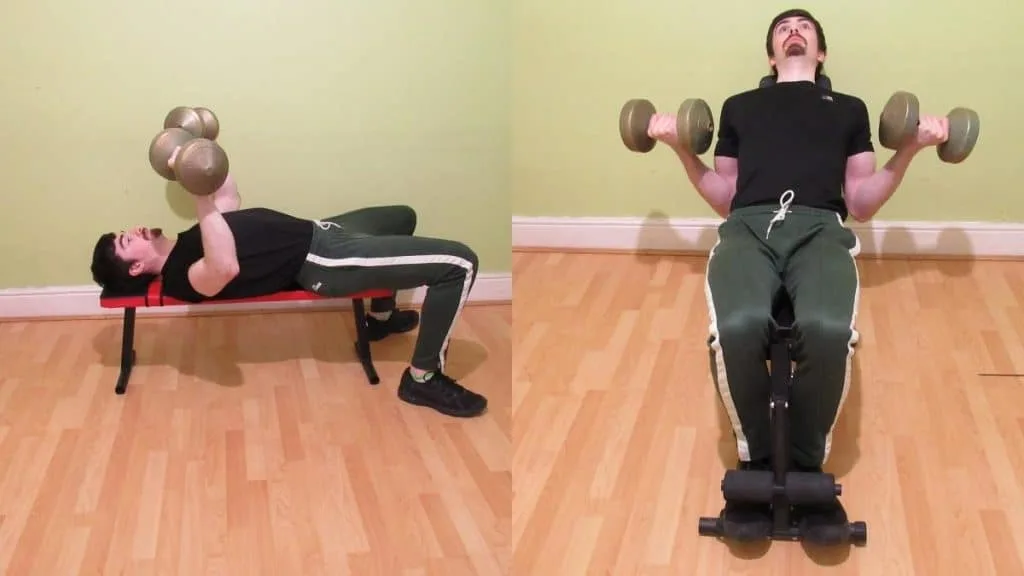
1: Weighted push-ups — 3-5 sets of 8-12 reps
2: Incline press — 3-5 sets of 10-12 reps
3: Cable fly — 3-5 sets of 15-20 reps
4: Incline curl — 3-5 sets of 8-10 reps
5: Preacher curl — 3-5 sets of 10-12 reps
6: Reverse drag curl — 3-5 sets of 15-20 reps
If you want to do everything in your power to build mass, then this is the best chest and bicep workout for you. It contains the most training volume out of all the routines and challenges your chest and bis from a variety of angles and with different reps ranges.
You’ll be starting with weighted push-ups to build overall mass and chest thickness. You might wonder why bench press isn’t the first exercise. And that’s because—truth be told—we much prefer push-ups for building size. Sometimes you need to be a bit unconventional in your exercise selection if you want to build unconventional amounts of mass!
Incline presses will take care of all your upper chest needs, and cable flys will finish off the pecs by ensuring that both your fast and slow-twitch muscle fibers get a great workout.
Then it’s onto the biceps. Incline curls focus on the long head of the biceps, whereas preacher curls emphasize the short head. The reverse drag curl builds the brachialis and brachioradialis, which means that in conjunction with the other two exercises, you’re hitting the front of your arms from every angle.
Should you train chest and biceps on the same day?
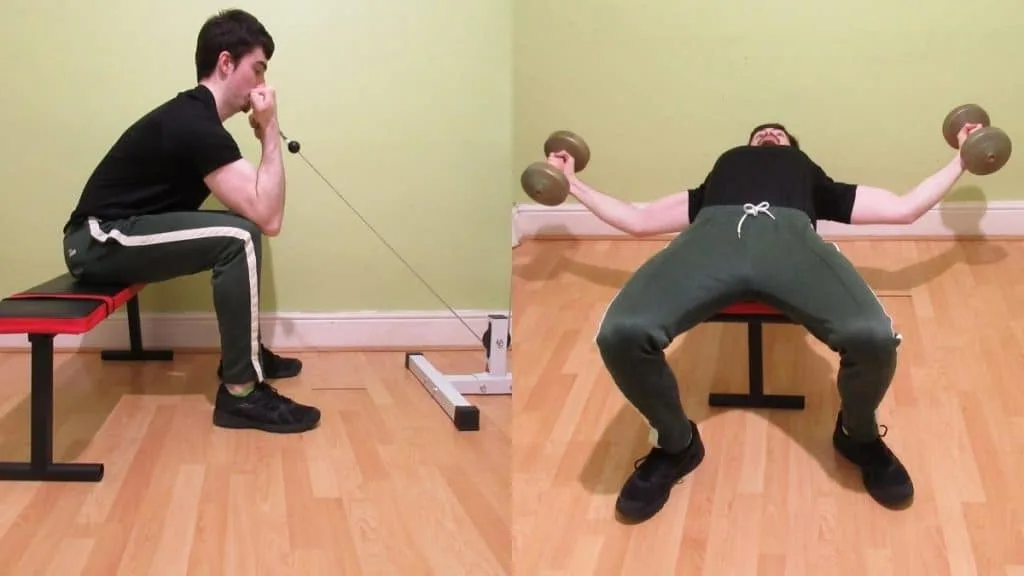
Yes, it is perfectly ok to work chest and biceps on the same day. Since these body parts don’t interfere with each other, you don’t need to worry about weakening yourself by mixing overlapping muscle groups.
Your best bet is to train your chest before your biceps (in the same session) because compound movements like bench presses and push-ups are generally more fatiguing than bicep curls.
Therefore, it’s best to perform these multi-joint exercises when you’re at your freshest.
You could even do a shoulder and bicep workout as well (on a different day, of course), because these two muscle groups also don’t interfere with each other.
That said, there are other options. You can check out our guide to learn whether you should do chest and triceps or chest and biceps.
Conclusion: How to maximize your chest and bicep day
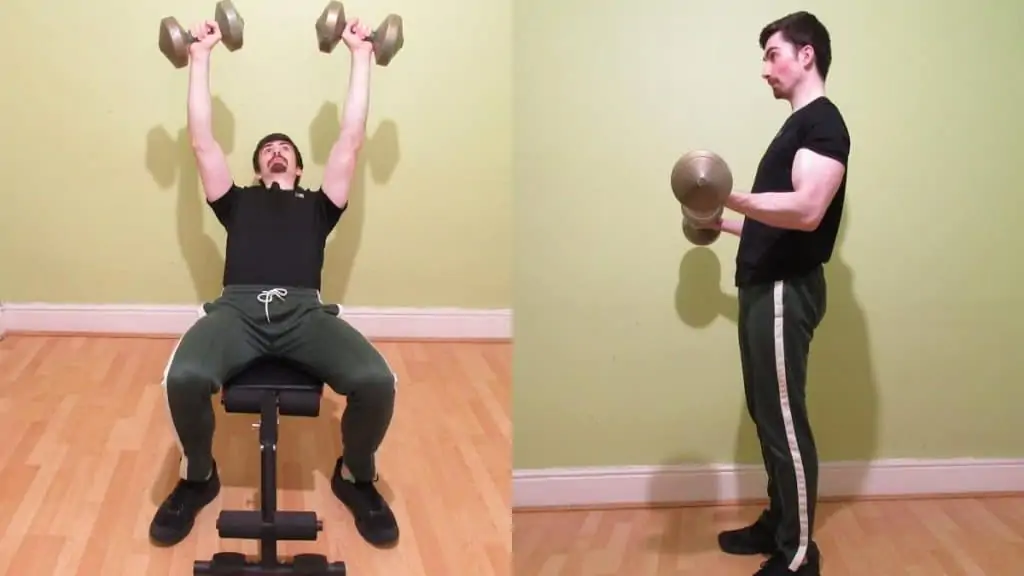
As mentioned, to get the most out of your chest and bicep day, you want to perform your compound movements at the start of the workout when you naturally have the most energy. That is, of course, unless your chest is already more developed than your biceps, in which case you may actually want to begin with curls.
Additionally, you can also perform a chest and bicep superset workout to save time since these muscle groups don’t interfere with each other (although the biceps do play a very minor stabilization role during pressing exercises).
If you want to gain maximum mass, however, then your best bet is to rest 2-4 minutes between sets so that you can lift as much weight as possible (and thereby perform more total training volume) on your subsequent sets.

